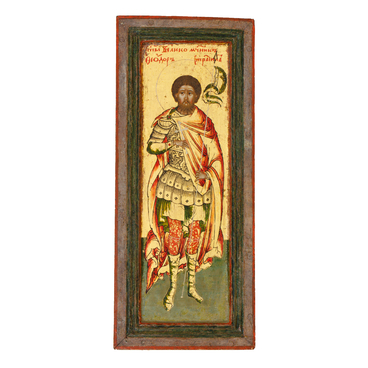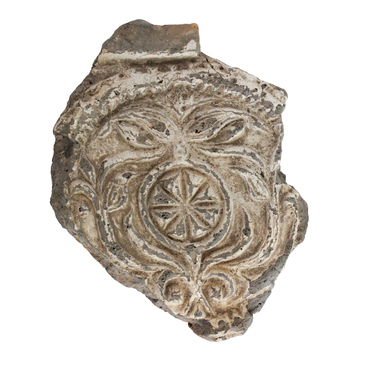The icon in a wrought silver setting entered the museum from the sacristy of the Solovetsky Monastery in 1923. The board of the icon is one-piece, with two counter keys and a double ark. The image is decorated with seven engraved corollas, and on the upper field is fixed a silver plate with the inscription ‘HOLY TRINITY’.
The composition of the image is quite complex and visually divided into two parts. The upper one depicts the Trinity, the backdrop of which is a rich building with a tower (probably the house of Abraham), the Oak of Mamre, under which the meeting took place, and steep ‘hills’ - a symbol of the rocky Israeli desert. The oak is framed by wrought silver. At the bottom of the image is the slaughter of the calf scene. In the lower left corner is the figure of Abraham with a cup in his hands, to the right is Sarah, kneading the dough. On the margins of the icon are saints: Saint Andrew and Saint Matrona.
The picture contains many symbolic images. The angel on the left symbolizes God the Father. This is evidenced by the image of the house of Abraham, placed above him, which corresponds to the initial moment of the Divine economy, carried out according to his will. The tree is the Oak of Mamre, depicted above the central figure, it can be interpreted as the tree of life, and is associated with the torment of Christ on the cross. Thus, the author depicted the central figure of the composition as the Son of God, Jesus Christ. As for the figure of the angel on the left, a hint of what it means is the mountain depicted above it - a symbol of spiritual ascent, carried out through the action of the third hypostasis of the Holy Spirit.
The iconography of the ‘Trinity’ is traditional for Orthodox church. The first images in which the Old Testament Trinity is represented appeared in the 2nd century on the walls of the Roman catacombs, where the first Christians performed divine services in secret from the pagan authorities. Finally, the composition of the ‘Holy Trinity’ in the form in which its most illustrious examples are created was formed in the 14th century.
To develop the image, the painter depicted the scene described in chapter 18 of the Book of Genesis. It is called ‘Hospitality of Abraham.’ Verses 1 through 18 describe how the forefather Abraham, during his day’s rest, was visited by three men. Seeing with spiritual eyes that God himself appeared before him in their image, Abraham showed them the greatest respect and hospitality. It is important to note that as the composition is completely static, the artist depicted the three angels as equals. This is emphasized by the blessing gesture of all three participants of the meal.



